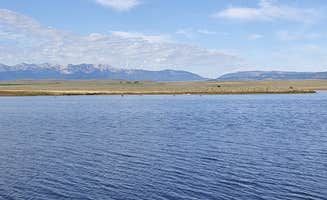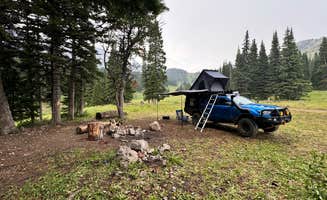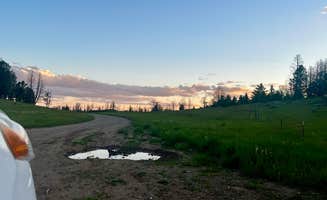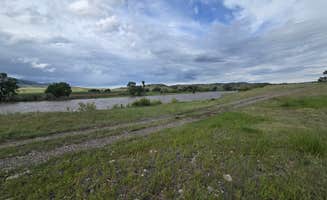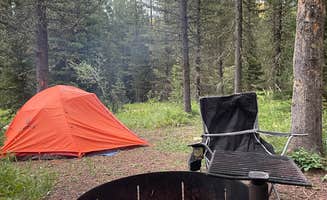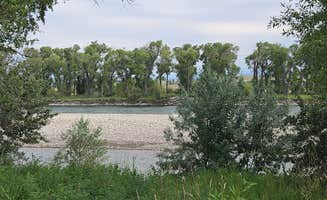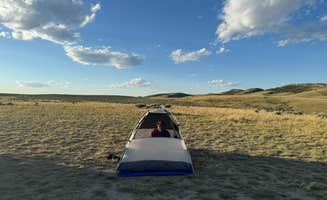Free camping near Wilsall, Montana exists primarily on National Forest and DNRC lands with elevations ranging between 5,000-8,000 feet, creating significant temperature variations between sites. Summer temperatures can drop below 40°F at higher elevation sites like Fairy Lake, while lower elevation sites maintain warmer overnight temperatures. Most dispersed camping locations require traveling 5-20 miles on unpaved roads, with conditions deteriorating after rain or snow events.
What to do
Fishing at Cottonwood Reservoir: Access Yellowstone cutthroat trout fishing at Cottonwood Reservoir Dispersed Camping. "The reservoir has Yellowstone cutthroat trout and white suckers," notes camper Owen T., making it a productive spot for anglers seeking native trout species.
Wildlife viewing at dawn/dusk: Best opportunities occur at lower-traffic sites with water access. "All kinds of waterfowl passing seasonal," reports a Cottonwood Reservoir camper, while sites near water sources typically see more diverse wildlife activity throughout summer months.
Night sky photography: The minimal light pollution near South Fork Brackett Creek Dispersed Site creates exceptional stargazing conditions. "Awesome view of the Northern Lights too!" mentions camper Tristan S., highlighting the area's potential for aurora viewing during geomagnetically active periods.
What campers like
Temperature relief from summer heat: Higher elevation sites provide natural cooling during hot months. "Olson Creek Dispersed is 15° cooler than Bozeman," reports camper Kenyon S., making it valuable during July-August heat waves when valley temperatures exceed 90°F.
Quick access from Bozeman: Several sites offer proximity to town while maintaining rural character. "Gorgeous campsite only 20ish min from the outskirts of Bozeman," shares camper Jenna B. about South Fork Brackett Creek, providing easy access for weekend trips without extended travel time.
Privacy between sites: Despite popularity, many areas maintain separation between campers. At Fairy Lake Dispersed Camping, "There's room for multiple vehicles" with "tree cover," notes John H., allowing for group camping while maintaining natural buffers between sites.
What you should know
Road deterioration after weather events: Access conditions change rapidly with precipitation. "I have a truck and was bouncing up and down the whole way!" warns Erik W. about Olson Creek's "single-lane cobblestone road," indicating high-clearance vehicles are essential during most conditions.
Train noise at riverside sites: Pig Farm Fishing Access Camp offers river access but with regular train disturbances. "Train whistles woke us up four times," notes camper Prudence T., highlighting the noise trade-off for waterfront locations near rail lines.
Seasonal occupancy patterns: Weekday availability differs significantly from weekends. "I went on a Thursday and had the area all to ourselves," reports Aliesha D. about Pig Farm Fishing Access, while most sites fill by Friday afternoon during summer months.
Tips for camping with families
Look for level parking areas: Families with multiple vehicles need specific site characteristics. At Fairy Lake Dispersed Camping, "This site is big enough for multiple vehicles," notes Ariana N., making it suitable for family groups requiring space for several cars.
Consider sites with natural shade: Summer sun exposure affects comfort significantly at treeless sites. "We went to the one furthest from the dirt road and had nice shade and privacy," shares James C. about sites along the Fairy Lake road, important for camping with children during hot weather.
Prioritize sites with established fire rings: Pre-existing fire rings indicate regular usage and maintenance. At Falls Creek Campground, "Each site is in the middle of trees and moss and directly next to the Boulder River. There is a picnic table and fire ring at each site," reports Stephany H., providing essential features for family camping.
Tips from RVers
Assess turning radius requirements: Many forest roads lack adequate turnaround space for longer vehicles. "I had to unhook our trailer to turn around," cautions Evan at Battle Ridge Dispersed, indicating the challenges for combined vehicle lengths exceeding 30 feet.
Plan for leveling challenges: Most dispersed sites require significant leveling equipment. "Pullout is on a corner turn" at Olson Creek, notes Antha A., creating uneven parking surfaces requiring blocks or hydraulic systems for larger RVs.
Consider site access timing: Road conditions deteriorate throughout peak season from increased traffic. "This is by far the roughest road I've encountered so far. Not for the faint of heart!" warns Ariana N. about Fairy Lake access, suggesting early-season visits for easier navigation with larger vehicles.


